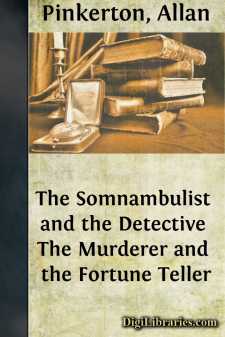Categories
- Antiques & Collectibles 13
- Architecture 36
- Art 48
- Bibles 22
- Biography & Autobiography 813
- Body, Mind & Spirit 138
- Business & Economics 28
- Children's Books 12
- Children's Fiction 9
- Computers 4
- Cooking 94
- Crafts & Hobbies 4
- Drama 346
- Education 46
- Family & Relationships 57
- Fiction 11821
- Games 19
- Gardening 17
- Health & Fitness 34
- History 1377
- House & Home 1
- Humor 147
- Juvenile Fiction 1873
- Juvenile Nonfiction 202
- Language Arts & Disciplines 88
- Law 16
- Literary Collections 686
- Literary Criticism 179
- Mathematics 13
- Medical 41
- Music 40
- Nature 179
- Non-Classifiable 1768
- Performing Arts 7
- Periodicals 1453
- Philosophy 64
- Photography 2
- Poetry 896
- Political Science 203
- Psychology 42
- Reference 154
- Religion 505
- Science 126
- Self-Help 81
- Social Science 81
- Sports & Recreation 34
- Study Aids 3
- Technology & Engineering 59
- Transportation 23
- Travel 463
- True Crime 29
The Somnambulist and the Detective The Murderer and the Fortune Teller
by: Allan Pinkerton
Categories:
Description:
Excerpt
PREFACE
In presenting to the public my third volume of Detective Stories, I desire to again call attention to the fact that the stories herein contained, as in the case of their predecessors in the series, are literally true. The incidents in these cases have all actually occurred as related, and there are now living many witnesses to corroborate my statements.
Maroney, the expressman, is living in Georgia, having been released during the war. Mrs. Maroney is also alive. Any one desiring to convince himself of the absolute truthfulness of this narrative can do so by examining the court records in Montgomery, Ala., where Maroney was convicted.
The facts stated in the second volume are well known to many residents of Chicago. Young Bright was in the best society during his stay at the Clifton House, and many of his friends will remember him. His father is now largely interested in business in New York, Chicago, and St. Louis. The events connected with the abduction of "The Two Sisters," will be readily recalled by W. L. Church, Esq., of Chicago, and others. The story of "Alexander Gay," the Frenchman, will be found in the criminal records of St. Louis, where he was sentenced for forgery.
So with the stories in this volume. The characters in "The Detective and the Somnambulist," will be easily recognized by many readers in the South. As the family of Drysdale are still living and holding a highly respectable place in society, the locality is not correctly given, and fictitious names are used throughout.
By reason of the peculiar nature of the circumstances, the facts narrated in "The Murderer and the Fortune-Teller," are known only to a small circle, but they can readily be substantiated. Captain Sumner was never informed of the means employed to influence his sister, and his first knowledge of them will be obtained in reading this book; but he will remember his own visit to "Lucille," and will undoubtedly see that the affair was managed exactly as I have stated.
In reading these stories, the reader will probably come to the conclusion that the detection of criminals is a very simple matter, and that any one with a moderate amount of intelligence could have done just as well. To a certain extent this is true, but not wholly. The plan once adopted, it is not difficult to put it in execution; but experience, judgment and tact are required to form a plan which will bring out the real facts connected with the crime. This done, the capture of the criminal is only a question of time.
Legitimate, honest detective business is yet in its infancy, but the trade, as at present generally conducted, approaches the dignity of an art—a black art, unfortunately, the object being accurately to distinguish the percentage of plunder which will satisfy the criminals and the real owners, the remainder being divided among the so-called detectives.
In point of fact, these fellows are worse than the acknowledged criminals, since they rob under the guise of honest men, and run little or no risk, while the actual thieves take their lives in their hands. It may safely be said that the average detective would rather be in league with the criminals of this city than opposed to them, and the great majority are so leagued; and until such a state of affairs is broken up, the criminals who have money will surely escape punishment.
ALLAN PINKERTON.
















